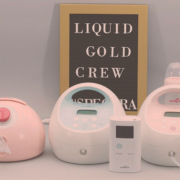Exclusively Pumping: Why and How

By Jennifer Gaskill
As a first-time mother, I experienced both the demanding and rewarding sides of providing breast milk for my child. My breastfeeding journey was unique and challenging. Like many moms today, my expressed breast milk saved the day. Nowadays, exclusively pumping, once the territory of mostly NICU moms, has become the chosen feeding option for more women.
Some women turn to pumping after dealing with latch and supply issues and/or lack of support at the start of their breastfeeding journey. For these women, pumping is the one way to supply breast milk to their child. Moreover, working mothers must build up a milk bank before going back to work, helping make the transition easier for both mom and baby. It is essential that moms considering pumping choose an efficient pump.
Choose the right tool
Most experts state that quality, closed-valve, hospital-strength pumps work best. Exclusive pumpers must choose a pump that can endure five or more sessions per day throughout the breastfeeding experience. Here are some tips for choosing a pump:
- Choose a pump with 250 mmHg or higher vacuum strength (also known as a hospital strength). Spectra’s single-user pumps are among the hospital-strength pumps recommended to exclusive pumpers. Moms can customize their settings to personalize vacuum pressure and cycle speed.
- If you cannot purchase a pump, you can rent one or buy a used one. When using these options, always choose a pump labeled as ‘multi-user’. Otherwise, the motor may not be designed to endure multiple users and an exclusive pumping regiment. Always purchase new accessories/parts; rentals and second-hand pumps include pump and motor only.
- Most insurance companies provide coverage for hospital-strength pumps. You can call your insurance plan or go online to determine your breast pump coverage. Breast pumps are issued by “DMEs” (durable medical equipment) and you can find one that works with your insurance plan here.
Timing is everything
Initially, exclusive pumpers should pump as often as the average newborn baby nurses (about 8-12 times per day). Experts recommend pumping every two to three hours. The timing starts from the beginning of one session to the beginning of the next. To protect your supply, avoid going longer than three hours between pumping sessions.
Maintaining breast milk supply
When starting out, it’s normal to see as little as 2 oz. combined per sessions. As supply builds, average daily output peaks at 19-30 oz. Around four to six months, supply naturally starts to self-regulate and milk composition changes often to a higher fat content. A similar shift occurs around 8-12 months. Keeping pace with baby’s feeding schedule will ensure your supply continues to meet baby’s needs. To keep the pump performing at its optimum, you must replace the accessories/parts periodically.
Maintenance and back-ups are essential
Be sure to regularly inspect and replace parts, especially valves and membranes. Exclusively pumping mothers should look to replace these parts every 2 months and part-time pumping mothers every 3 months. Worn, damaged, or incorrect parts are often to blame for supply fluctuations. Furthermore, have at least one backup set of replacement parts/accessories available in case of emergency.
Support for exclusive pumping moms is out there. Whether it comes from a close-knit group of friends, a lactation consultant, or an internet community of like-minded moms. We all know providing breast milk for baby is a labor of love, and having the appropriate supplies and resources makes the journey so much easier. You can join our support community on Facebook here.









Leave a Reply
Want to join the discussion?Feel free to contribute!